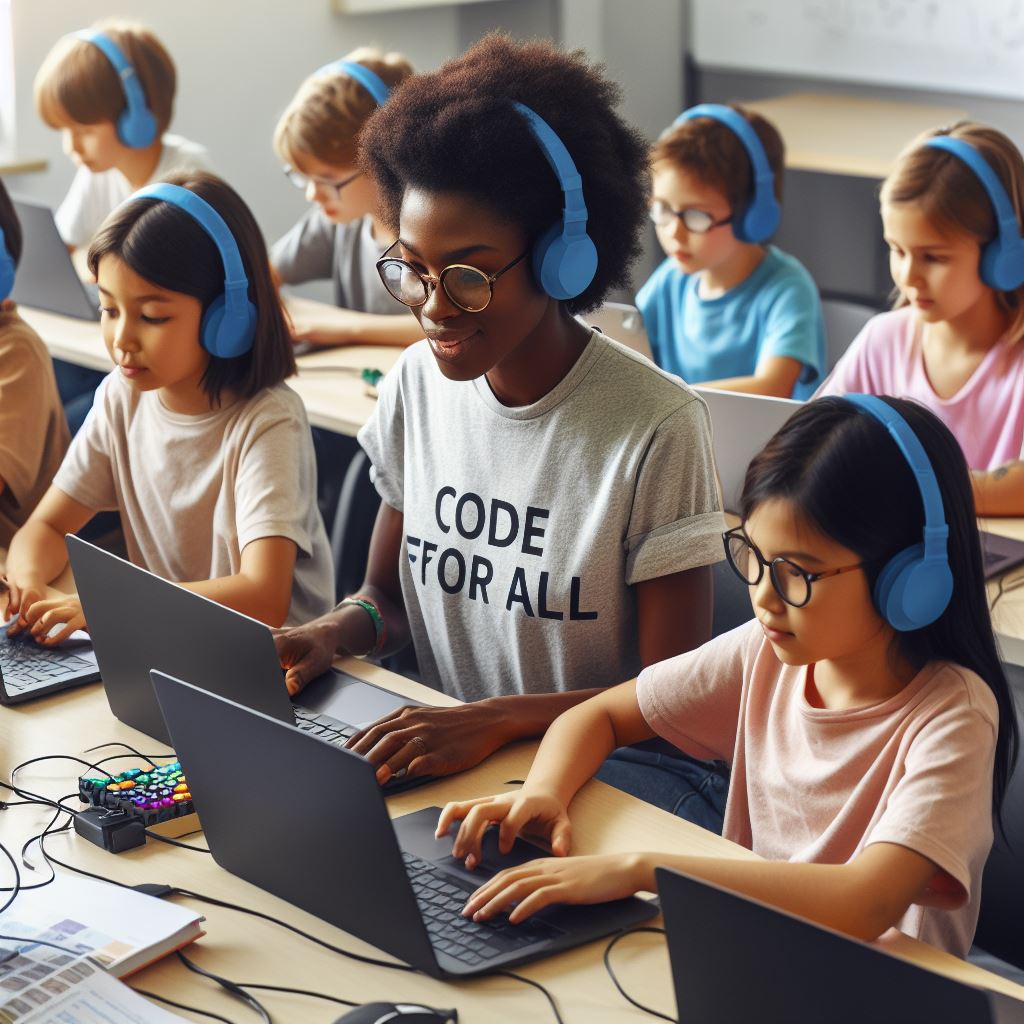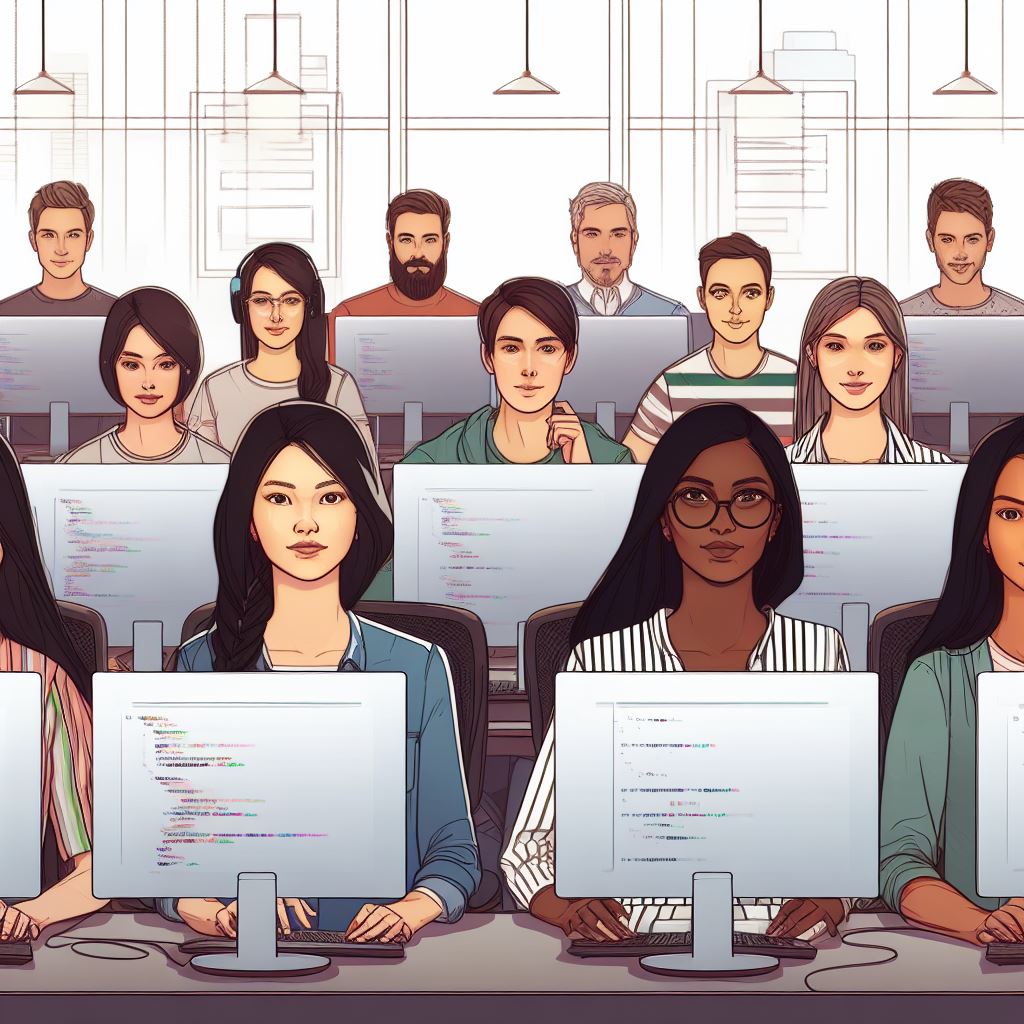Introduction
In today’s digital age, coding and programming skills are paramount, shaping future careers and fostering innovation.
Parents increasingly recognize this importance, leading to a surge in teaching coding and programming to kids.
This section explores the nuances between coding and programming, shedding light on what parents need to know.
- Digital Literacy: Understanding coding and programming is crucial for digital literacy, equipping kids for the future job market.
- Problem-Solving Skills: Both coding and programming enhance problem-solving abilities, encouraging analytical thinking from a young age.
- Creativity and Innovation: Coding fuels creativity, allowing kids to create games, animations, and interactive stories.
- Algorithmic Thinking: Programming delves deeper, teaching algorithmic thinking, a foundational skill in computer science.
- Future Opportunities: Proficiency in programming opens diverse career paths, from software development to artificial intelligence.
- Empowering Kids: Teaching coding and programming empowers kids, fostering confidence in technology-driven environments.
- Differentiation: While coding involves writing scripts, programming encompasses designing algorithms, offering a comprehensive skill set.
- Parental Guidance: Understanding these distinctions enables parents to guide their children effectively in the digital realm.
Embracing these skills early shapes young minds for a tech-driven future, nurturing a generation adept in both coding and programming.
Defining Coding and Programming
In order to understand the difference between coding and programming, it is necessary to define both terms and explore their purpose and relationship:
Brief explanation of coding and its purpose
- Coding refers to the process of writing instructions using a programming language to make a computer perform specific tasks.
- It involves creating a set of instructions, known as code, that can be executed by a computer.
- The purpose of coding is to provide step-by-step instructions for a computer to follow and accomplish a specific task or problem.
- Coding allows humans to communicate with computers and automate various processes.
Definition of programming and its role in creating software and applications
- Programming is the broader term that encompasses coding and other tasks involved in the development of software and applications.
- It involves designing, planning, and creating a program that solves a problem or fulfills a specific purpose.
- Programmers are responsible for analyzing requirements, writing code, testing, and debugging.
- The role of programming is to transform an idea or concept into a working software or application.
Highlighting the relationship between coding and programming
- Coding is one of the key components of programming.
- It involves translating logical instructions into a language that computers can understand.
- Programming involves a wider range of activities like problem-solving, algorithm design, and system analysis.
- Coding is a subset of programming, focusing on writing the actual code and implementing the logic.
- While coding focuses on the syntax and structure of the code, programming encompasses the entire development process.
In summary, coding is the process of writing instructions using a programming language, while programming encompasses a broader range of tasks in software development.
Coding is an essential part of programming, as it enables the translation of human instructions into a format that computers can understand.
Understanding the relationship between coding and programming can help parents gain insight into the skills their children are acquiring through coding education.
Read: Coding Memes That Make Even Non-Coders Laugh
Coding for Kids
In recent years, there has been a significant emergence of coding programs and courses specifically designed for children.
This trend is driven by the increasing recognition of the importance of coding skills in the digital age.
Let us delve into the reasons why teaching coding to kids is beneficial and explore some of the kid-friendly coding platforms and languages available.
Emergence of Coding Programs and Courses for Children
- Various organizations have developed coding programs and courses catering to the needs and interests of children.
- These programs often feature age-appropriate content and incorporate gamification elements to engage young learners.
- With the increasing demand for coding skills, parents are actively seeking opportunities to introduce their children to coding at an early age.
- Coding programs for kids have gained popularity due to their ability to nurture computational thinking and problem-solving abilities.
Benefits of Teaching Coding to Kids
Teaching coding to kids has numerous advantages that go beyond simply learning how to write code. Here are some of the key benefits:
- Problem-solving skills: Coding helps children develop critical thinking and problem-solving abilities as they learn to break down complex problems into smaller, more manageable tasks.
- Logic development: Coding encourages logical reasoning and enhances a child’s ability to follow logical sequences and create step-by-step solutions.
- Creativity: Coding empowers children to express their creativity by allowing them to design and develop their own projects and ideas.
- Future-ready skills: As technology continues to shape the world, coding proficiency will become increasingly vital for future career success.
Kid-Friendly Coding Platforms and Languages
To make coding more accessible and engaging for children, several kid-friendly coding platforms and languages have been introduced. Here are a few notable examples:
- Scratch: Scratch is a visual programming language designed for children aged 8-16. It uses colorful blocks to create animations, games, and interactive stories.
- Code.org: Code.org offers a range of coding courses targeted at different age groups, starting from early elementary to high school. Their curriculum incorporates popular characters like Elsa from Frozen and Minecraft.
- Tynker: Tynker provides an intuitive coding platform that uses a graphical interface. It offers various game-based coding courses and allows kids to create their own apps and games.
- Robot Turtles: Robot Turtles is a board game that introduces programming concepts to children aged 4 and up. It teaches coding fundamentals in a fun and interactive way.
Coding programs tailored for kids have gained traction due to their ability to develop problem-solving, logic, and creativity skills.
Parents can leverage kid-friendly coding platforms and languages to introduce their children to coding and prepare them for a future dominated by technology.
By nurturing coding skills from an early age, parents can equip their children with a valuable toolset that will benefit them in various aspects of life.
Read: Regional Salary Differences for Coders in the United States
Programming for Kids
In this section, we will delve into the world of programming for kids and discuss the similarities and differences between coding and programming.
We will also explore the transition from coding to more comprehensive programming concepts and introduce programming languages suitable for young learners.
Exploring the Difference between Coding and Programming for Kids
- Coding is a subset of programming that focuses on writing instructions for computers using a programming language.
- Programming, on the other hand, involves designing, developing, and implementing algorithms to solve complex problems.
- While coding is a fundamental skill, programming expands children’s problem-solving abilities and teaches them logical thinking.
- Coding helps kids understand the basics, while programming empowers them to create innovative solutions.
- By starting with coding, children can gradually progress to programming as they gain a deeper understanding of computational concepts.
- Both coding and programming provide children with valuable skills for the future, such as critical thinking and creativity.
Transition from Coding to More Comprehensive Programming Concepts
- As kids become comfortable with coding, they can begin exploring more advanced programming concepts.
- They can learn about variables, conditionals, loops, functions, and other foundational elements of programming.
- Understanding these concepts allows children to develop more complex and interactive programs.
- They can create games, simulations, animations, and even websites, showcasing their creativity and problem-solving abilities.
- Transitioning from coding to programming expands children’s computational thinking skills and prepares them for future challenges.
- It’s important to provide kids with opportunities to apply their knowledge and practice solving real-world problems through programming.
Introduction to Programming Languages Suitable for Young Learners
- When introducing programming to kids, it’s crucial to choose languages that are beginner-friendly and visually appealing.
- Scratch is a popular visual programming language that uses blocks to create interactive stories, games, and animations.
- Python, another beginner-friendly language, offers a smooth transition from visual programming to text-based coding.
- Java and C++ are more advanced languages suitable for older kids who want to explore professional programming.
- Online platforms and coding tools provide interactive environments for kids to learn and practice programming.
- Parents can encourage their children to explore different programming languages and tools to find their preferences.
Coding serves as an excellent starting point for kids, laying the foundation for programming skills.
As children transition from coding to more comprehensive programming, they develop advanced problem-solving abilities and creativity.
Introducing them to suitable programming languages tailored for young learners expands their computational thinking and equips them for the future.
Read: Customizing Your IDE: Tips to Personalize Your Coding Editor

Curriculum and Learning Approaches
In order to fully understand the differences between coding and programming education for kids, it is important to delve into the curriculum and learning approaches used in these fields.
This section will address the importance of age-appropriate curriculum, provide an overview of coding and programming education in schools, and compare traditional classes with online resources and self-paced learning tools.
Importance of Age-Appropriate Curriculum
When introducing coding or programming to kids, it is crucial to have an age-appropriate curriculum that aligns with their cognitive abilities and interests.
This ensures that the learning experience is engaging and productive.
Tech Consulting Tailored to Your Coding Journey
Get expert guidance in coding with a personalized consultation. Receive unique, actionable insights delivered in 1-3 business days.
Get StartedBenefits of an age-appropriate curriculum:
- Focuses on foundational concepts before diving into complex coding or programming languages.
- Integrates fun and interactive activities to maintain children’s interest and motivation.
- Encourages critical thinking and problem-solving skills development in a developmentally appropriate manner.
Overview of Coding and Programming Education in Schools
Coding and programming education in schools has gained significant popularity in recent years. Many educational institutions have recognized the importance of teaching these skills to prepare children for the future job market.
Key aspects of coding and programming education in schools:
- Integration into the school curriculum as a standalone subject or as a part of STEAM (Science, Technology, Engineering, Arts, Mathematics) education.
- Emphasis on hands-on, project-based learning to enhance practical skills and creativity.
- Introduction to coding and programming concepts through user-friendly graphical interfaces and block-based programming languages.
- Encouragement of teamwork, collaboration, and communication through group projects and coding challenges.
Comparison of Coding and Programming Classes vs. Online Resources and Self-Paced Learning Tools
Parents have various options when it comes to providing coding and programming education to their children. They can opt for traditional classes or utilize online resources and self-paced learning tools.
Advantages of coding and programming classes:
- Structured and organized learning environment with experienced instructors.
- Opportunity for real-time interaction and collaboration with peers.
- Access to specialized equipment and resources provided by educational institutions.
- Regular assessments and feedback to track progress and identify areas for improvement.
Advantages of online resources and self-paced learning tools:
- Flexibility in scheduling and learning at the child’s own pace.
- Availability of a wide range of online tutorials, videos, and coding platforms.
- Opportunity for independent exploration and experimentation.
- Access to global coding communities for sharing projects and seeking advice.
Important considerations for choosing between coding classes and online resources:
- Learning style and preferences of the child – some children thrive in a structured classroom setting, while others prefer independent learning.
- Availability of resources and access to technology at home.
- Cost implications of classes and online subscriptions.
- Time commitment and parents’ ability to support self-paced learning.
Selecting an age-appropriate curriculum and learning approach is essential for providing quality coding and programming education to kids.
Schools offer structured classes, while online resources and self-paced learning tools provide flexibility and independence.
Parents should consider their child’s preferences, resources, and learning style when making this decision.
Read: HTML, CSS, JavaScript: Coding for Web Development
Parental Involvement and Support
Role of parents in motivating and supporting their children’s coding and programming interests
Parental involvement and support play a crucial role in motivating and supporting their children’s coding and programming interests.
When parents actively participate in their children’s learning journey, the benefits are far-reaching. Here are some ways parents can get involved and support their kids in coding and programming:
- Understand the Basics: Parents can start by familiarizing themselves with the basics of coding and programming. This will enable them to have meaningful conversations with their children and provide guidance when needed.
- Encourage Curiosity: Parents should encourage their children to explore and experiment with coding and programming. This can be done by providing them with opportunities to interact with coding toys, games, and online platforms designed for kids.
- Provide Resources: Parents can invest in age-appropriate coding books, online courses, and educational software to help their kids further develop their coding skills. Making these resources easily accessible to children can foster their interest and passion for coding and programming.
- Be a Learning Partner: Parents can become actively involved in their children’s coding and programming endeavors by becoming learning partners. This involves working together on coding projects, solving problems, and providing guidance when necessary.
- Attend Workshops and Events: Parents can seek out coding workshops, camps, and events in their community that cater to children. This provides an opportunity for kids to interact with like-minded peers and learn from experienced mentors.
Parental involvement and support are essential in nurturing children’s coding and programming interests.
By actively engaging and supporting their children, parents can inspire a lifelong passion for coding and equip their kids with valuable skills for the future.
So let’s join hands with our children and embark on this adventurous coding and programming journey together.
Challenges and Considerations
In the previous sections, we have discussed the benefits of coding and programming for kids, the different approaches to teaching them, and the essential skills they can gain.
However, it is important to acknowledge that learning coding and programming can come with its own set of challenges.
In this section, we will explore potential challenges children may face and how parents can support them in overcoming these obstacles.
Potential Challenges Children May Face
- Complexity: The world of coding and programming can be overwhelming for children, given the complex concepts and technical jargon.
- Frustration: Learning to code requires patience and perseverance, as children may encounter errors and bugs along the way.
- Limited Resources: Access to reliable technology and appropriate learning resources may be a challenge for some children.
The Importance of Persistence and Problem-Solving Skills
When faced with these challenges, it is crucial for children to develop persistence and problem-solving skills.
Coding and programming often involve debugging and troubleshooting, which requires analytical thinking and the ability to solve problems.
By persisting through challenges, children learn the value of perseverance and develop a growth mindset.
They understand that making mistakes is part of the learning process and that finding solutions to problems is a rewarding experience.
Ways Parents Can Help Overcome Challenges
As a parent, there are several strategies you can employ to support your child in overcoming challenges in coding and programming:
- Create a supportive learning environment: Encourage your child to explore coding in a comfortable and non-judgmental space.
- Encourage collaboration: Promote teamwork and collaboration by organizing coding clubs or encouraging your child to participate in coding competitions.
- Provide appropriate resources: Ensure your child has access to reliable technology and age-appropriate coding tutorials or websites.
- Celebrate small victories: Acknowledge and celebrate your child’s progress to boost their confidence and motivation.
- Be a learning partner: Show interest in your child’s coding projects, ask questions, and encourage them to explain their thought processes.
- Model problem-solving behavior: Demonstrate problem-solving techniques and encourage your child to think through challenges systematically.
By implementing these strategies, parents can foster a growth mindset in their child, where they view challenges as opportunities to learn and grow.
While learning coding and programming can present challenges for children, it is important to remember that overcoming obstacles is part of the learning process.
By emphasizing the importance of persistence and problem-solving skills, parents can support their child’s growth in these fields.
With the right encouragement and resources, children can develop a passion for coding and programming that will benefit them throughout their lives.
Future Opportunities and Career Prospects
As technology continues to evolve at a rapid pace, the demand for coding and programming skills is growing not only in the tech industry but also across various other sectors.
Here, we discuss the importance of introducing kids to coding and programming early on and how it can open up a world of future opportunities and career prospects.
Growing Demand in Various Industries
- The tech industry is not the only sector where coding and programming skills are sought after.
- Industries like healthcare, finance, gaming, and even arts and media are embracing technology.
- Medical professionals use programming to develop innovative healthcare solutions and improve patient care.
- Financial institutions rely on coding for data analysis, algorithmic trading, and risk management.
- Game development requires programming skills to create immersive gaming experiences.
- Artists and media professionals use coding to enhance their creative output and engage with audiences.
Potential Career Paths and Opportunities
- Coding and programming skills can lead to a wide range of career paths for kids in the future.
- They can become software developers, web designers, or app developers.
- Data analysts or scientists, cybersecurity professionals, or artificial intelligence engineers are also possible options.
- With the rise of the Internet of Things (IoT), there will be a demand for experts in this field.
- Robotics, automation, and machine learning are also areas where coding skills will be in high demand.
Long-Term Benefits for Children
- By introducing coding and programming to children early on, parents are preparing them for the future.
- These skills enhance problem-solving abilities, creativity, logical thinking, and attention to detail.
- Coding promotes a growth mindset by encouraging kids to persist through challenges and find solutions.
- Understanding how technology works gives children a sense of empowerment and digital literacy.
- The ability to code allows kids to shape the future and contribute to technological advancements.
Coding and programming are not just valuable skills for the tech industry. They have become essential in various sectors as technology continues to advance.
By exposing children to coding at an early age, parents open up a world of future opportunities and career prospects for them.
From healthcare to finance, gaming to media, coding skills are in demand across industries.
The potential career paths include software development, data analysis, cybersecurity, and AI engineering, among others.
Moreover, coding fosters essential skills like problem-solving, creativity, and logical thinking.
It empowers children to understand and shape technology, preparing them for a digitally-driven future.
Therefore, parents should seriously consider the long-term benefits and encourage their children to explore the world of coding and programming.
Build Your Vision, Perfectly Tailored
Get a custom-built website or application that matches your vision and needs. Stand out from the crowd with a solution designed just for you—professional, scalable, and seamless.
Get StartedConclusion
It is important for parents to understand the differences between coding and programming.
Key points discussed in this blog post include the fact that coding is a subset of programming, focusing on the implementation of instructions, while programming involves the entire process of designing, coding, and testing software.
Understanding these differences can help parents better support their children’s interests in coding and programming.
By recognizing the potential benefits of both activities, parents can encourage their kids to explore these fields further.
By exposing children to coding and programming at an early age, parents can help them develop problem-solving skills, logical thinking, and creativity.
Moreover, parents should support and nurture their kids’ interests, providing them with resources, courses, and opportunities to further enhance their skills.
By recognizing the importance of coding and programming in today’s digital world, parents can empower their children to succeed in future careers and adapt to a rapidly changing technological landscape.
Parents play a crucial role in shaping their children’s interests and skills, and understanding the differences between coding and programming is an essential step in supporting their development.
So, let’s encourage our kids and pave the way for their success in coding and programming!




